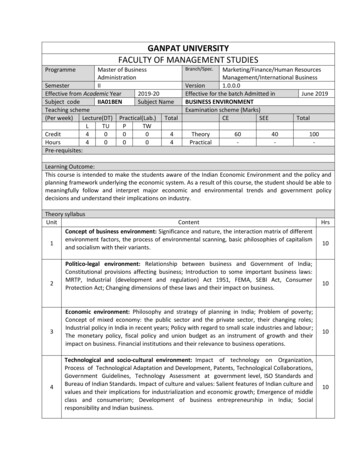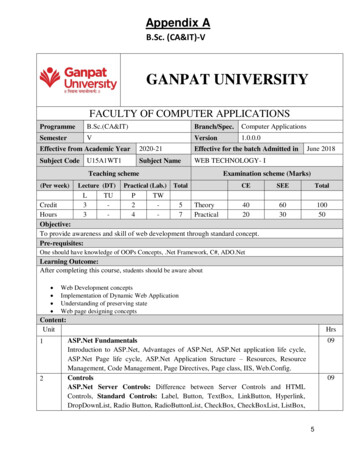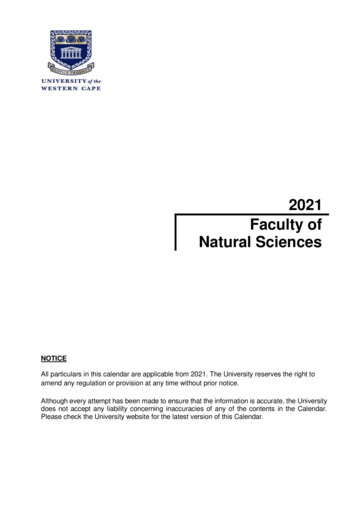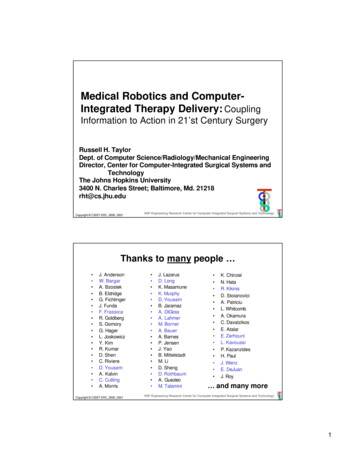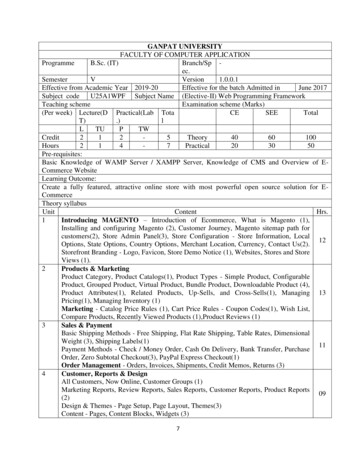
Transcription
GANPAT UNIVERSITYFACULTY OF COMPUTER APPLICATIONProgrammeB.Sc. (IT)Branch/Sp ec.SemesterVVersion1.0.0.1Effective from Academic Year 2019-20Effective for the batch Admitted inJune 2017Subject codeU25A1WPF Subject Name (Elective-II) Web Programming FrameworkTeaching schemeExamination scheme (Marks)(Per week) Lecture(D Practical(Lab urs2147Practical203050Pre-requisites:Basic Knowledge of WAMP Server / XAMPP Server, Knowledge of CMS and Overview of ECommerce WebsiteLearning Outcome:Create a fully featured, attractive online store with most powerful open source solution for ECommerceTheory syllabusUnitContentHrs.1Introducing MAGENTO – Introduction of Ecommerce, What is Magento (1),Installing and configuring Magento (2), Customer Journey, Magento sitemap path forcustomers(2), Store Admin Panel(3), Store Configuration - Store Information, Local12Options, State Options, Country Options, Merchant Location, Currency, Contact Us(2).Storefront Branding - Logo, Favicon, Store Demo Notice (1), Websites, Stores and StoreViews (1).2Products & MarketingProduct Category, Product Catalogs(1), Product Types - Simple Product, ConfigurableProduct, Grouped Product, Virtual Product, Bundle Product, Downloadable Product (4),Product Attributes(1), Related Products, Up-Sells, and Cross-Sells(1), Managing 13Pricing(1), Managing Inventory (1)Marketing - Catalog Price Rules (1), Cart Price Rules - Coupon Codes(1), Wish List,Compare Products, Recently Viewed Products (1),Product Reviews (1)3Sales & PaymentBasic Shipping Methods - Free Shipping, Flat Rate Shipping, Table Rates, DimensionalWeight (3), Shipping Labels(1)11Payment Methods - Check / Money Order, Cash On Delivery, Bank Transfer, PurchaseOrder, Zero Subtotal Checkout(3), PayPal Express Checkout(1)Order Management - Orders, Invoices, Shipments, Credit Memos, Returns (3)4Customer, Reports & DesignAll Customers, Now Online, Customer Groups (1)Marketing Reports, Review Reports, Sales Reports, Customer Reports, Product Reports09(2)Design & Themes - Page Setup, Page Layout, Themes(3)Content - Pages, Content Blocks, Widgets (3)7
Practical contentList of programs specified by the subject teacher based on above mentioned topicsText Books1Reference Books1Magento Beginner's Guide, Second Edition, Robbert Ravensbergen, Sander Schoneville,Published by Packt Publishing Ltd.2Magento User Guide (https://docs.magento.com/m2/ce/user ide.html)Note for ExaminerQ-1 Must be common from any topics from syllabus.Q-2 And onwards must be from specific topics and internal choice or option can be givenPaper StructureQ-1 (Attempt any Six Out of Eight: each question must be 5 marks ) --- 30Questions must be covered all possible section.Q-2 (Must be From topics: Introducing MAGENTO (8 marks))Q-3 (Must be From topics: Products & Marketing (8 marks))Q-4 (Must be From topics: Sales & Payment (7 marks))Q-5 (Must be From topics: Customer, Reports & Design (7 marks))Note:Version 1.0.0.0 (First Digit New syllabus/Revision in Full Syllabus, Second Digit Revision inTeaching Scheme, Third Digit Revision in Exam Scheme, Fourth Digit Content Revision)L Lecture, TU Tutorial, P Practical/Lab., TW Term work, DT Direct Teaching, Lab. Laboratory workCE Continuous Evaluation, SEE Semester End Examination8
GANPAT UNIVERSITYFACULTY OF COMPUTER APPLICATIONBranch/Spec.ProgrammeB.Sc. (IT)Department of Computer ScienceSemesterVVersion1.0.0.0Effective from Academic Year2017-18Effective for the batch Admitted inJune 2015Subject codeU25A1NINSubject Name(Elective - II) Internetwork ImplementationTeaching schemeExamination scheme (Marks)(Per week) Lecture(DT) Practical(Lab.) 147Practical203050Pre-requisites:Basic Routing ProtocolsLearning Outcome:This paper will provide details on the Routing and Switching conceptsTheory syllabusUnitContentHrs1Network Basics8Internetwork basics , OSI , Ethernet , TCP/IP , IP Addressing , Subnetting , VLSM ,troubleshooting TCP/IP2345Managing IOS , Routers , SDMUnderstanding OSPF Fundamentals, Configuring OSPF within Single Area, Cost, Understandingthe differences between OSPF Network Types, Using OSPF Across Multiple Area- Features,Router Types, Link- State Advertisements, Different Types Of Areas, Propagation of LSAs,Special OSPF Area, Authentication, Wan topologies of OSPFIP RoutingRouting basics and process , types of routing , routing protocols , Protocol dependent modules ,network discovery , VLSM support , Route discovery and maintenance , EIGRP- OSPF basics ,configuring EIGRP , load balancing with EIGRP, verifying and Troubleshooting EIGRP,OSPFSwitching, VLANSwitching Services, STP, Configuring Catalyst Switches, CNA, VLAN Basics, Membership, VLANTrunking Protocol, Configuration of VLAN, VTP, Configuring Inter VLANSecurity, NAT, Wireless Technology, IPV6, WANSecurity, Threats, Introduction to ACL, Types of ACL, Monitoring Access lists, NAT Basics, Typesof NAT, Configuring, Testing & Troubleshooting NAT, Introduction to Wireless Technology,Basics of IPv6, WAN basics, WAN connection types, WAN protocols, Frame Relay, VPN basics.9810910
Practical contentList of programs specified by the subject teacher based on above mentioned topicsText Books1CCNA Todd Lammle- Wiley Publishing,Inc.Reference Books12Note for ExaminerQ-1Must be common from any topics from syllabus.Q-2 And onwards must be from specific topics and internal choice or option can be givenPaper StructureQ-1 (Attempt any Six Out of Eight: each question must be 5 marks ) --- 30Questions must be covered all possible section.Q-2 (Must be From topics: Network Basics (5 marks))Q-3 (Must be From topics: Managing IOS , Routers , SDM (5 marks))Q-4 (Must be From topics: IP Routing (7 marks))Q-5 (Must be From topics: Switching, VLAN (6 marks))Q-6 (Must be From topics: Security, NAT, Wireless Technology, IPV6, WAN ( 7 marks))10
GANPAT UNIVERSITYFACULTY OF COMPUTER APPLICATIONBranch/Spec.ProgrammeB.Sc. (IT)Department of Computer ScienceSemesterVVersion1.0.0.0Effective from Academic Year2017-18Effective for the batch Admitted inJune 2015Subject codeU25A2IMASubject Name(Elective - III) Advance Mobile Application DevelopmentTeaching schemeExamination scheme (Marks)(Per week) Lecture(DT) Practical(Lab.) 147Practical203050Pre-requisites:Basic knowledge of the Android Programming, Database Concepts.Learning Outcome:To make all types of android applicationTheory syllabusUnitContentHrs117Advance Layout of AndroidLayouts (List view, Grid Layout, Card Layout, Drawer Layout) (8) Types of Adapter.(Array, Base and custom) (4), Use of Fragments (3) , Floating Button (2).2Animation, Theme and Maps APIWorking with Dialogs, Working with Styles, Working with Themes (3). Drawingand Working with Animation - Drawing on the Screen, Working with Bitmaps,Working with Shapes, Working with Animation(4), Working map API (5).123Working with SQLite Database and APIDDMS, Use of Sharedpreferences (2), Android Data and Storage API: Working withFiles and Directories (2), SqliteOpenhelper, Content provider (2), Various operationsusing SQLite database (5), Sending SMS, Making and Receiving Phone Calls (4).154Webservice and parsingWhat is webservice? Creating webservice (4), What is XML parsing? Using XMLparsing (4), Overview of Volley library, What is JSON parsing? Using JSON parsing(5)1311
Practical contentList of programs specified by the subject teacher based on above mentioned topicsText Books1Lauren Darcey and Shane Conder, “Android Wireless Application Development”, rence Books1Reto Meier, “Professional Android 2 Application Development”, Wiley India Pvt Ltd ent.in.24.Hours.2nd.Edition.Paper StructureQ-1 (Attempt any Six Out of Eight: each question must be 5 marks ) --- 30Questions must be covered all possible section.Q-2 (Must be From topics: Advance Layout of Android (8 marks))Q-3 (Must be From topics: Animation, Theme and Maps API (7 marks))Q-4 (Must be From topics: Working with SQLite Database and API (8 marks))Q-5 (Must be From topics: Webservice and parsing (7 marks))12
GANPAT UNIVERSITYFACULTY OF COMPUTER APPLICATIONBranch/Spec.ProgrammeB.Sc. (IT)Department of Computer ScienceSemesterVVersion1.0.0.0Effective from Academic Year2017-18Effective for the batch Admitted inJune 2015Subject codeU25A2CMSSubject Name(Elective - III) CMS ProjectTeaching schemeExamination scheme (Marks)(Per week) Lecture(DT) Practical(Lab.) 147Practical203050Pre-requisites:Basic knowledge of Content Management SystemLearning Outcome:Student can arrange content smarter and more powerful. Because content is stored only one time no matterhow many times it is used, the system can track everything that happens to it. And editors only have tohandle the content one time while the changes are made globally within and across all documents.UnitContentHrsExamination WeightageInternal ExaminationInternal HeadExternal ExaminationWeightage (60%)Presentations (3)15 %Project Analysis10 %Project Designing05 %Technical Parameters10 %Answer to queries10 %Project Outcomes10 %External HeadFinal Viva Presentation(Project Analysis, ProjectDesigning, TechnicalParameters etc)Report SubmissionWeightage (40%)25 %15 %Rules for the Project:(1) The duration of the project work is approximately 90 Hrs excluding thestudy and reporting work. The students can do their project work individuallyor in a group, but the work must be sufficient in order to justify the duration androle.(2) The passing standard will be as per GNU policy.13
(3) The project can be done by seeking prior approval from the institution.Generally the purpose of approval includes submitting their project titles andproposals to the Project Coordinator of Institution within 15 days of thecommencement of the fifth semester. In case, if the student proposal isrejected, the revised proposal in the same or other area, is required to submit andget it sanctioned within next 5 working days. Failing to do this, His/her coursewill not be granted.(4) The students have to report as per schedule declared during the project life spanwith the progress report but in any of case the minimum 3 reporting is must.Moreover they have to bring these reports with the final report at the time offinal report at the time of external examination.(5) The external examiners appointed by the University will give the external markson the basis of the heads like Presentation, Demonstration, Viva Voice,Documentation etc. The distribution of the marks to different heads may bedecided at the time of evaluation of the project but it is expected to havethe same distribution.(6) The Project Coordinator will be responsible to award the internal marks basedon performance and keeping records for the same.Practical contentNAText Books1NAReference Books1NA14
GANPAT UNIVERSITYFACULTY OF COMPUTER APPLICATIONProgrammeBranch/Spec.B.Sc. (IT)SemesterVEffective from Academic YearSubject codeU25A2NSEDepartment of Compute ScienceVersion1.0.0.0Effective for the batch Admitted in2017-18Subject Name(Elective - III) Network SecurityTeaching schemeExamination scheme (Marks)(Per week) Lecture(DT) Practical(Lab.) ical2030Pre-requisites:Basic knowledge of networkLearning Outcome:Being expert in concepts of Network Security.Theory syllabusUnitContent1Introduction of Network Security, Fundamentals & Cryptography23June 2015Total10050What is network Security? Network Security ConceptSecurity attacks: threats, attacks, types of attack, passive attack, active attack, SecurityServices: Authentication, Access Control, Data Confidentiality, Data Integrity, Nonrepudiation, Availability Service, Security Mechanisms, A Model for Network Security,Symmetric cipher: Types of Attacks on Encrypted Messages, Symmetric cipher model,Cryptography: Plain text and Cipher Text, Secret keyClassical Encryption TechniquesOverview of Polyalphabetic Substitution and Hill Cipher, Overview of Substitutiontechniques: Caesar Cipher, Monoalphabetic Cipher, Playfair, One time pad ,Transposition techniques: Encryption and Decryption, Rotor machine, Symmetric andAsymmetric Key Cryptography, Steganography, Key Range and Key Size, Principles ofPublic Key Cryptosystems, Application for Public Key Cryptosystem, Requirements forPublic Key Cryptography, Digital Signature: Generic Model for Digital SignatureProcess, Attacks and Forgeries, Digital Signature Requirements, Digital SignatureStandardNetwork and Internet SecuritySecure Sockets Layer (SSL) Architecture, SSL Record Protocol, Alert Protocol,Handshake Protocol, Transport Layer Security (TLS), HTTPS, SSH: Secure ShellProtocol Stack, SSH Transport Layer Protocol Exchange, WAP: Operational Overview,Wireless Markup Language with WAP infrastructure, WAP Architecture, ElectronicMail Security: General Format of PGP message, Multipurpose Internet Mail Extensions:15Hrs091212
4Overview of MIME and its Content types, Overview of S/MIME and its Functions,Internet Mail: Internet Mail Architecture and its Component (Function Modules andStandardised Protocol for the Internet), Email Threat, Domain Key Identified Key(DKIM): Deployment and Functional FlowNetwork Attacks and IP SecurityNetwork Attacks: SYN Attack, Sniffer Attack, Man-in-Middle-Attack, IP addressSpoofing Attack, ARP Spoofing Attack, DNS Spoofing Attack, Phishing and FarmingAttack, Backdoor Attack, SQL Injection Attack, Types of Malware: Adwares, Toolbarsand Hijackers, Key loggers, Computer Viruses- Types of Computer Viruses, Worms,Logic Bombs, Trojan Horses, Root Kits, IP Security: IPSec Architecture, IP SecurityScenario- Application of IPSec, Benefits of IPSec, Routing Application, SecurityAssociation Database for IPSec Implementation, Overview of Encapsulation SecurityPayload (ESP), ESP Format,Firewall: What is Firewall, Characteristics of Firewall, Types of Firewall, Host baseFirewall, Personal Firewall, Distributed Firewall1612
Text Books1Cryptography and Network Security Principles and Practice, 5th Edition, William StallingsReference Books1Network Security Essentials: Applications and Standard, 4th Edition, William StallingsNote for ExaminerQ-1Must be common from any topics from syllabus.Q-2 And onwards must be from specific topics and internal choice or option can be givenPaper StructureQ-1 Attempt any Five Out of Seven: each question must be 6 marks --- 30 MarksQuestion must be covered all possible topics.Q-2 Must be from topic: Introduction of Network Security, Fundamentals & Cryptography --09 MarksQ-3 Must be from topic: Classical Encryption Techniques -- 09 marksQ-4 Must be from topic: Network and Internet Security -- 06 MarksQ-5 Must be from topic: Network Attacks and IP Security -- 06 Marks17
GANPAT UNIVERSITYFACULTY OF COMPUTER APPLICATIONProgrammeBachelor of Science inBranch/Sp Bachelor of Science in terVVersion1.0.0.0Effective from Academic Year 2019-20Effective for the batch Admitted inJune 2019Subject codeU25A2IML Subject Name (Elective – III ) Introduction to Machine LearningTeaching schemeExamination scheme (Marks)(Per week) Lecture(D Practical(Lab urs2147Practical203050Pre-requisites:The basic knowledge of C and C .Learning Outcome:Getting the knowledge of python programming.Theory syllabusUnitContentHrs112Python File & Data Handling(12)Files: Files, Types of Files in Python, Opening a File, Closing a File, Working with TextFiles Containing Strings, Knowing Whether a File Exists or Not, Working with BinaryFiles (06)Regular ExpressionsREs and Python: Regular Expressions, Sequence Characters inRegular Expressions, Quantifiers in Regular Expressions, SpecialCharacters in Regular Expressions, Using Regular Expressions onFiles, Retrieving Information from a HTML File (06)2Advanced Topics : Plotting and Data Science, Data Visualization(12)Data Science Using Python: Data Frame (Creating Data Frame from an ExcelSpreadsheet, Creating Data Frame from .csv Files, Creating Data Frame from a PythonDictionary, Creating Data from Python List of Tuples, Operations on Data Frames),(8)12Data Visualization : Bar Graph, Histogram, Creating a Pie Chart, Creating Line Graph(4)3.Machine Learning Introduction (10)Introduction to AI, AI Features, AI Applications, Artificial Intelligence VS MachineLearning, Why Machine Learning?, Categories of ML, Applications of ML, NNIntroduction, NN Architecture (10)1810
4.ML Tools (11)I/O: retrieves data from files or data bases11Data Manipulation: pre-processes your input data with filtering, group-by, pivoting,binning, normalization, aggregation, joining, sampling, partitioning, etc.Views: inspects the data and results with several interactive views, supportinginteractive data explorationMining: uses state-of-the-art data mining algorithms like clustering, rule induction,decision tree, association rules, naïve bayes, neural networks, support vector machines,etc. to better understand your data (11)Practical contentList of programs specified by the subject teacher based on mentioned above topics.Text Books1Kenneth A. Lambert, The Fundamentals of Python: First Programs, 2011, Cengage Learning,ISBN: 978-11118227052Machine Learning using Python [Print Replica] Kindle Editionby U Dinesh Kumar Manaranjan Pradhan (Author)3KNIME – Quick Guide [ebook]4PowerBI – Step By Step [ebook]5IBM Watson Analytics Hand Book [ebook]Question Paper Scheme:University Examination Duration: 3 HoursPaper StructureQ-1 (Attempt any Six Out of Eight: each question must be 5 marks) --- 30Questions must be covered all possible Topics.Q-2 (Must be from topic:1(10 Marks))Q-3 (Must be from topic: 2 (5 Marks))Q-4 (Must be from topic: 3 (5 Marks))Q-5 (Must be from topic:4 (10 Marks))Note:Version 1.0.0.0 (First Digit New syllabus/Revision in Full Syllabus, Second Digit Revision in TeachingScheme, Third Digit Revision in Exam Scheme, Forth Digit Content Revision)L Lecture, TU Tutorial, P Practical/Lab., TW Term work, DT Direct Teaching, Lab. Laboratory workCE Continuous Evaluation, SEE Semester End Examination19
GANPAT UNIVERSITYFACULTY OF COMPUTER APPLICATIONProgrammeBranch/Spec.B.Sc. (IT)Department of Compute ScienceSemesterVVersion1.0.0.0Effective from Academic Year2017-18Effective for the batch Admitted inSubject codeU25A3OPSSubject NameOperating SystemTeaching schemeExamination scheme (Marks)(Per week) Lecture(DT) Practical(Lab.) ical2030Pre-requisites:Some Fundamental Knowledge of Operating SystemLearning Outcome:To provide the knowledge in operating system.Theory syllabusUnitContent1Introduction to OS2June 2015Total10050Introduction to OS, Function of OS (2)Different types of OS: (6) Batch Processing Operating System Multiuser Multi Programming Time Sharing or Multi-tasking Network Real timeOS Structure: (4) Monolithic Layered Approach: Virtual machine, Client-Server.Introduction to Process : (6)The Process Model,Process Creation,Process Termination,Process Hierarchies,ProcessState, Process Control BlockMemory ManagementMemory Management: (8) Basic Memory Management Swapping Contiguous Memory Allocation20Hrs1812
Fragmentation Compaction Paging Page Table SegmentationVirtual Memory System (4) Demand Paging Page Replacement Allocation Frames34Process ManagementIntroduction to cooperating process, preemptive process (2)Process Synchronization (2)Critical Section Problem (2)Two Process Solution, Multiple Process Solution (2)Deadlock and Characterization (2)(PRACTICAL BASED ON UNIX)10Introduction: (6)Introduction to Linux System & History, Features of Linux, Introduction to File System(Only ext2fs file system), Introduction to Memory ManagementBasic Commands: (2)[Login, Logout, date (Format: %, a, A, b, B, c, d, D, H, I, j, k, l, m, M, p, S, T, w, x, y,Y),Man, who, who ami ( - m, q, u, H ), ls – 1, l, r, S, t , pwd , mkdir – p, rmdir – p,Cd,Useof wild card character - ?, *, [.]],Types of FAP, use of chmod command, Environmentvariables.File and Directories Command: (5)cp – i, p, R, u, mv – i, f, u, rm – i, d, f, r, rev, file redirection – , , , grep – c, e, E, f, h, i, l, n, v, x, ., *, [ ], , , (pipe), ( ) , cut - c, f, dpaste – d, s, sort – b, c, f, k, m, n, o, r, t, uIntroduction to vi editor: (3)Mode (Command, Input and Last line), Insert & append : i, a, I, A, Replace: r, R, s, S,Open a line: o, O, Saving: w, x, wq, q, ZZ, Navigation: h, j, k, l, Word navigation: b, w, e,Moving to line extremes: 0, , , G , Editing: d, y, x, ddMoving: p, P, Joining: J, Undoing: u, U, Searching: /, ?, n, N, s2116
5Basics of Shell Scripting ProgrammingCreating Shell Scripts using various commands of Linux except Filters. Interactive shell script using read and echo Decision Statements: if then fi, if then else fi, if then elif else fi, case esac Test command Logical Operators Looping statements: for loop, while loop, until loop Break, continue command Arithmetic in Shell script using exprCreating Shell Scripts to perform mathematical calculations14Text Books1Andrew S. Tanenbaum: Operating System Design & Implementation, Prentice HallInternationalReference Books1 James Peterson and Abraham Silberschatz: Operating System Concept, AdditionWesley, Sixth Edition Linux Commands Instant Reference- Bryan Pfaffenberger. BPB Publication Advanced Linux Programming- Samual, Techmedia Publications UNIX Concepts & Application 4th Edition by Sumitabha Das Microsoft Windows Server 2008 : A Beginner’s Guide - Marty Matthews,published byMcGraw-HillNote for ExaminerQ-1Must be common from any topics from syllabus.Q-2 And onwards must be from specific topics and internal choice or option can be givenPaper StructureQ-1 (Attempt any Six Out of Eight: each question must be 5 marks) --- (30 marks))Questions must be covered all possible section.Q-2 (Must be From topics: Introduction to Operating System (8marks))Q-3 (Must be From topics: Memory Management & Virtual Memory (6 marks))Q-4 (Must be From topics: Process Management (6 marks))Q-5 (Must be From topics: Basic commands, File and Directory Commands, VI editor, Basics ofShell Scripting Programming (10 marks))22
GANPAT UNIVERSITYFACULTY OF COMPUTER APPLICATIONSBranch/Spec.ProgrammeB.Sc. (IT)Department of Computer ScienceSemesterVVersion1.0.0.0Effective from Academic Year2017-18Effective for the batch Admitted inJune 2015Subject codeU25A4STQSubject NameSoftware Testing & Quality AssuranceTeaching schemeExamination scheme (Marks)(Per week) Lecture(DT) Practical(Lab.) 3PracticalPre-requisites:Familiarity with System design and analysis (SAD) and Software Engineering (SE).Learning Outcome:This course presents a comprehensive study of software testing and quality control concepts, principles,methodologies, management strategies and techniques. The emphasis here is on understanding softwaretesting process, planning, strategy, criteria, and testing methods, as well as software quality assuranceconcepts & control process.Theory syllabusSectContentHrsion1SW Testing Overview and Needs: Introduction to V&V with importance, market 05234scenario. Career Opportunities. Why Should we test, Verification/Validation.Independent V&V. Phases of Software Testing, Testing Models, Alignment withSoftware Development Models, Application Testing/Product TestingSW Testing Techniques: Static & Dynamic Testing techniques, White Box, Black BoxTesting Techniques. User Interface Testing - Form Level Validation & Inter-Formdependencies, Field Level validation and Inter-Field dependencies, Error MessagesValidation.SW Testing Levels and Types: Unit Testing, Integration Testing, System Testing, UserAcceptance Testing. Functional & Non Functional Testing, Regression Testing,Overview of Security Testing, Performance and Load Testing, Localization &Internationalization Testing, Usability Testing, Exploratory Testing, CompatibilityTesting Role base Access Testing, Mobility testing.SW Testing Process – Phases: Test Strategy and Planning, Requirement Understandingand Ambiguity reviews – Importance, Ambiguity types, Test case Design, Test23150807
Execution, Defect management. Tools, Test Data.5SW Testing Optimization: Test Automation – automation process, benefits, tools,Overview of Selenium tool. Risk Based Testing, Orthogonal array.056SW Testing Quality and Case Study: Coverage, Defect detection efficiency, DefectAcceptance rate, Quality of Test Deliverables.04Practical contentNILText Books1Software Testing (A Practical Approach) Rajiv ChopraReference Books1The Art of Software Testing - by Glenford J Myers2Software Testing – Principles and Practices - by Srinivasan Desikan&Gopalswamy RameshNote for ExaminerQ-1 Must be common from any topics from syllabus.Q-2 And onwards must be from specific topics and internal choice or option can be given.Paper StructureQ-1(Attempt any Six Out of Eight: each question must be 5 marks) --- 30Questions must be covered all possible section.Q-2(Must be from topics: Software Testing Needs & Overview (4 marks)Q-3(Must be from topics: Software Testing Techniques (10 marks)Q-4(Must be from topics: SW Testing Levels and Types (8 marks)Q-5(Must be from topics: SW Testing Process – Phases (5 marks)Q-6(Must be from topics: SW Testing Optimizations SW Testing Quality and Case Study(3 marks)24
GANPAT UNIVERSITYFACULTY OF COMPUTER APPLICATIONSBranch/Spec.ProgrammeB.Sc. (IT)Department of Computer ScienceSemesterVVersion1.0.0.0Effective from Academic Year2017-18Effective for the batch Admitted inJune 2015Subject codeU25A5SADSubject NameSystem Analysis and DesignTeaching schemeExamination scheme (Marks)(Per week) Lecture(DT) Practical(Lab.) 3PracticalPre-requisites:Basic Computer system knowledgeLearning Outcome:Student can analyse, design and evaluate the information systemTheory syllabusSectContention1Introduction to System Analysis and design Introduction AND Types of System ,Characteristics of System, Need forsystem development(2.5) Types Of User, Role of system Analyst(01) Introduction to Information System (02)o Types Of Information System System Development Strategies(03)o System Development Life Cycle Structure Analysis Strategies(07)o Physical And Logical DFDo Data Dictionary System Prototyping Model(01) System Investigation (02)o Fact finding Techniques Tools for Documenting And Decision(2.5)o Decision Treeo Decision Tableo Structured English25Hrs21
234System Design and CASE Tools Code Design(1.5)o Principal of Code Designo Types Of Code Design Form Design(1.5)o Types Of Formso Principle of form Designo Consideration of form Designo Steps for Form Design Input Design(03)o Objective of Input Designo Data capturing guidelineso Input validation Output Design(02)o Objective of Outputo Types of Outputo Different ways to represent Informationo Designing Special Forms Computer Aided System Tools(02)o Benefits of Computer assisted toolso Categories Of automated Toolso CASE Tools File and Database Design(02)o Basic File Terminologyo Types of Fileo Method of File OrganisationTesting and Quality Assurance Testing Strategies(01) Level Of Testing(1.5) Managing Quality Assurance(1.5) Training And Conversion(01) Post Implementation Review(01)Case Studies Payroll System(2) Billing System(1) Library System(1) Financial Accounting System(1) Inventory Management System(1)261266
Practical contentN.A.Text Books1Analysis and Design of Information Systems - James A. Senn-TMHReference Books1System Analysis and Design, 1st Edition, - S.Parthasarthy & B.W.Khalkar, Master Academy2Introduction to S.A.D. by LEE VOL. 1 & 2 Galgotia PublicationNote for Examiner:Q-1 Must be common from any topics from syllabus.Q-2 And onwards must be from specific topics and internal choice or option can be given.Paper Structure:Q-1 Attempt any Six Out of Eight: each question must be 5 marks: (30 Marks)Questions must be covered all possible section.Q-2 Must from topics: Introduction to System Analysis and design (Introduction to systemand information system, type of user and role of system Analyst, SDLC): (05 marks)Q-3 Must from topics: Introduction to System Analysis and design (System analysisStrategy, prototype Model, system Investigation, tools for documentation and decision) (05marks)Q-4 Must from topics: System Design and CASE Tools(Code design, Form design, Inputdesign, Output design, File and Database Design): (06 marks)Q-5 Must from topics: Computer Aided System Tools, Testing and Quality Assurance: (07marks)Q-6 Must from topics: Case Studies (07 marks)27
Installing and configuring Magento (2), Customer Journey, Magento sitemap path for customers(2), Store Admin Panel(3), Store Configuration - Store Information, Local Options, State Options, Country Options, Merchant Location, Currency, Contact Us(2). Storefront Branding - Logo, Favicon, Store Demo Notice (1), Websites, Stores and Store Views (1 .


